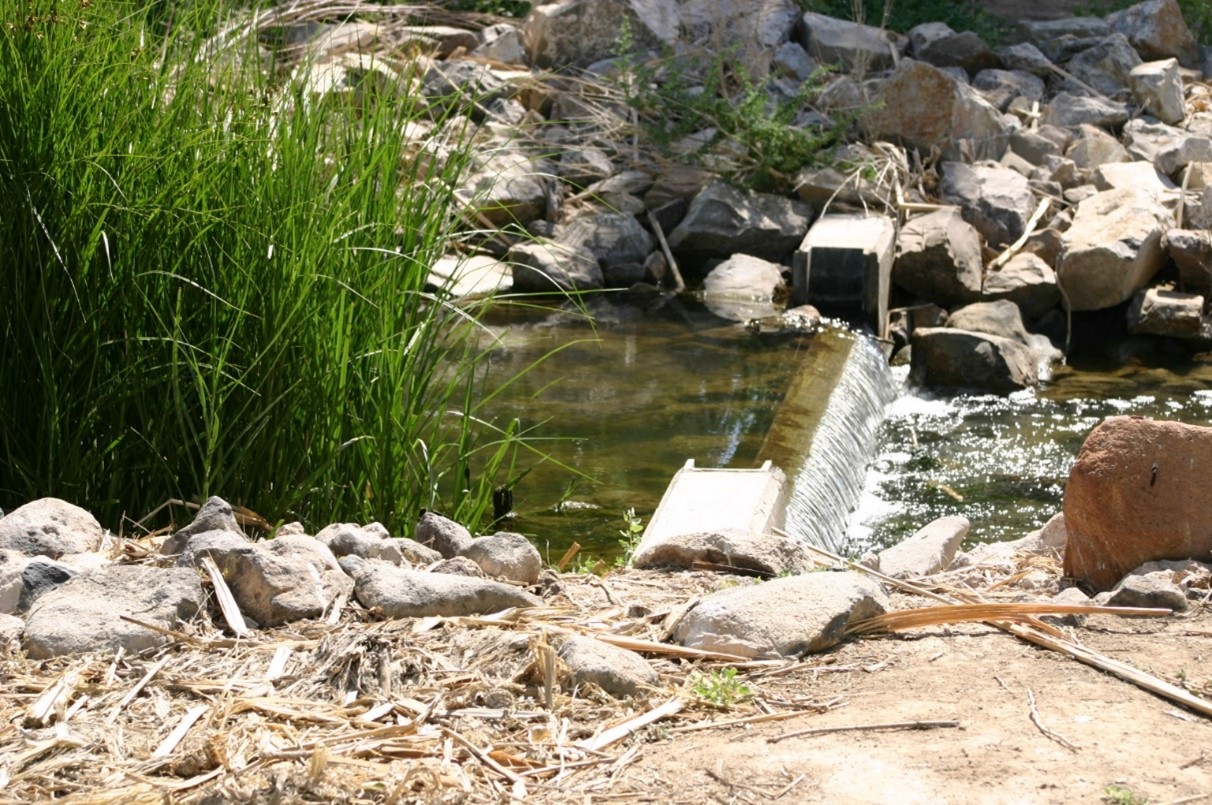The Weir

WHAT’S THAT SOUND OF FLOWING WATER IN WETLANDS PARK?
Weirs (the name rhymes with “deer”) are vitally important manmade structures found throughout Clark County Wetlands Park and many regions in the world where water is a precious commodity. At first glance, these devices look like dams or “rapids” and sound like trickling water or waterfalls, but they aren’t exactly that. Weirs are constructed to “slow the flow” of water so it flows through the structure, not just over the top or through spillways.
In arid places where mining (and other industries), agriculture, and living populations within towns and cities depend upon discrete, reliable water sources, water management takes center stage. Weirs help conserve existing water sources by controlling the flow of their energy for good use.
One common saying in the West is that “whiskey is for drinking and water is for fighting over.” That saying has often been all too true. Fortunately, the Park doesn’t have to fight for the water that makes it a unique wetlands in the Mohave Desert. Erosion control and water quality management are important parts of the Park’s mission. Twenty-two large, highly engineered weirs slow water flow and reduce erosion and head cutting in the seven-and-a-half-mile length of the Las Vegas Wash channel within the Park’s boundaries. In fact, some of these weirs look like sections of “rapids in a river,” with water flowing around rocks! Flows traveling down the Wash (west to east) include highly treated reclaimed water (used by homes and businesses), untreated urban flows, and sometimes huge storm flows. Daily non-storm flows average approximately 200 million gallons a day – the volume of a small river! All that water nourishes the Park’s wetland habitats, and the weirs give the water a final quality “polish” on its way downstream to Lake Mead.
Within the Nature Preserve (the westernmost 210-acres of the Park), weirs are much smaller and simpler to maintain than those in the main Las Vegas Wash channel. Like the weir shown in the photo, each is made with a set of removable boards that drop into slots within poured concrete walls on pond outflows. Weirs of this type are often called “agricultural weirs” as they are commonly used in irrigation systems for crop fields.
In the Nature Preserve system, Park staff members add boards (the boards are 4×4 lumber) to weir slots to hold more water back when they want to increase the depth of water in upstream ponds or remove boards when they want to decrease pond depth. This control of water volume and depth allows Park habitats to thrive, wildlife variety to increase, exotic and aggressive plant species to be managed, and mosquitoes and other disease vectors to be controlled. For human visitors, the sound of streams flowing, the cooler air in the green corridor of riparian trees and shrubs that follow the water, and the calm and beautiful vistas across open water ponds provide much-needed respite from the heat and “twenty-four-seven” hustle of the Park’s urban surroundings.
Nature Preserve ponds and streams receive reclaimed water daily, direct from the Clark County Water Reclamation’s treatment facility just upstream of the Park’s boundary. The water flows through two engineered pond and stream systems in the Preserve and is discharged downstream into the Las Vegas Wash. Park staff can open or close supply valves at the entrances of the pond systems to reduce or even cut off water flow as needed for repair or maintenance. This kind of work is generally scheduled during the winter months, when most plants are dormant and bird populations are not migrating or nesting.
The Nature Preserve’s ponds and streams were deliberately created on the site to enhance its role as the Park’s hub for habitat variety and watchable wildlife, and to provide a green oasis in the desert where visitors can enjoy and learn about nature. As you ramble the Nature Preserve trails, check out the ponds and listen for the soothing sound of flowing water. Keep an eye out for wildlife like herons and egrets hunting beside the weirs. It’s amazing what a few “good boards” can do!
– By Chris Levitt; photo from Wetlands Park Archives
Please enjoy this YouTube video: Did you know Las Vegas has a marsh? / Clark County Wetlands Park (Nature Preserve weir at work at 2:16)
